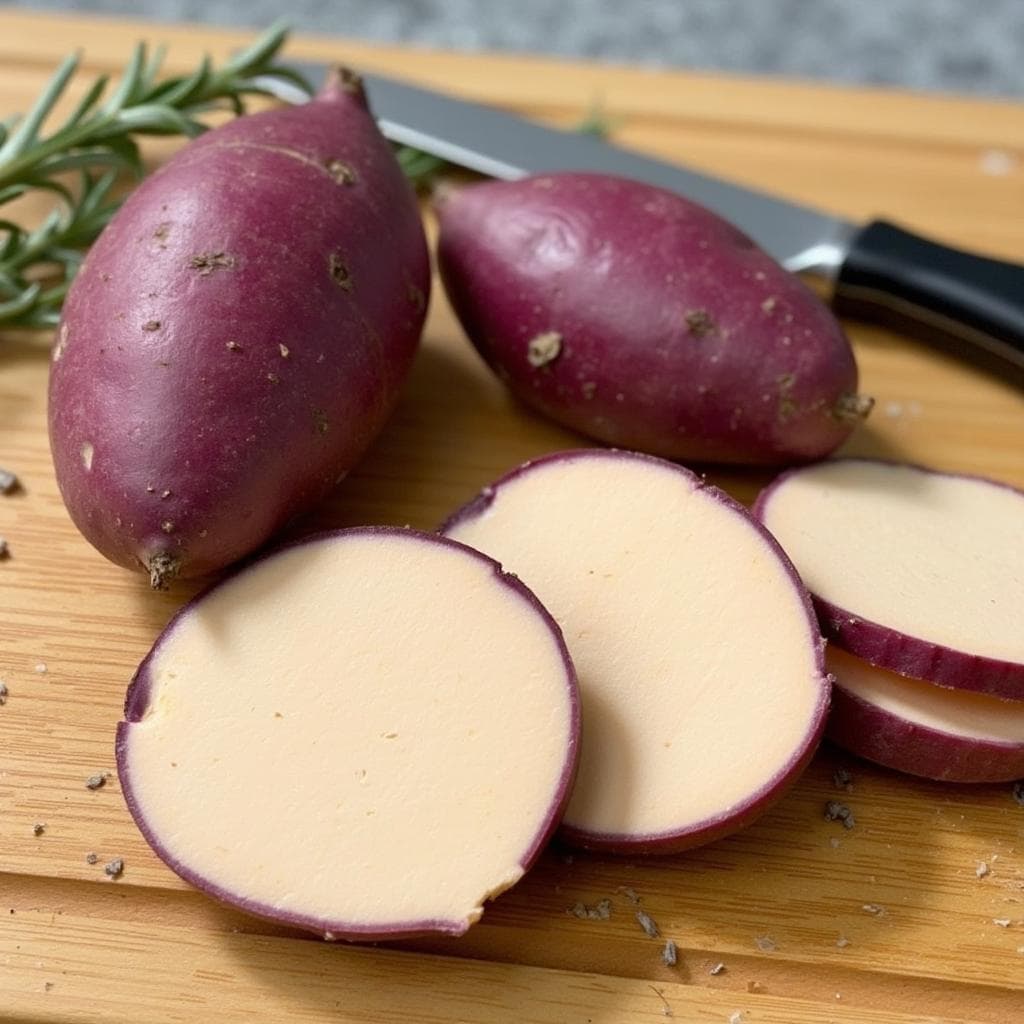Murasaki sweet potatoes add vibrant color and unique flavor to many dishes. With their deep purple skin and creamy flesh, they stand apart from traditional orange varieties. Their nutty, mildly sweet taste and smooth texture make them versatile and easy to prepare. These qualities allow Murasaki sweet potatoes to fit seamlessly into a variety of cuisines and diets.
Their subtle sweetness complements both savory and sweet recipes. Whether roasted, mashed, or included in creative desserts, they bring flavor and nutrition to the table.
What Are Murasaki Sweet Potatoes?

Murasaki sweet potatoes are a type of sweet potato with purple skin and off-white flesh. Originating in Japan, their name translates to “purple.” They are known for their nutty flavor with a hint of chestnut and a drier texture compared to orange-fleshed varieties. Their taste is mild rather than overly sweet, making them a popular alternative to traditional sweet potatoes.
Their long, slender shape and thin skin make them easy to cook. When roasted, the skin becomes crisp, adding texture and flavor to dishes. These potatoes’ distinct qualities have gained popularity worldwide, appealing to both home cooks and professional chefs.
Origins and History
Sweet potatoes were introduced to Japan centuries ago via trade routes from the Americas. Over time, farmers cultivated several varieties, including Murasaki sweet potatoes. Japan’s climate and volcanic soil contributed to their unique flavor and texture.
Today, these potatoes are grown not only in Japan but also in parts of the United States. Their increasing availability in grocery stores and farmers’ markets has brought their distinctive taste to a broader audience.
Nutritional Profile of Murasaki Sweet Potatoes
Murasaki sweet potatoes are rich in fiber, vitamins, and minerals. Key nutrients include:
- Vitamin A and C: Support immune health and skin vitality.
- Potassium: Promotes healthy blood pressure levels.
- Manganese: Supports bone health and metabolism.
While they have less beta-carotene than orange sweet potatoes, Murasaki sweet potatoes offer antioxidants that help protect cells. Their moderate glycemic index makes them a good option for those managing blood sugar levels.
Cooking methods like steaming and roasting preserve their nutrients. Whether included in a side dish or a main course, they add both flavor and health benefits.
Health Benefits
Including Murasaki sweet potatoes in your diet can provide several health advantages:
- Digestive Health: Their fiber content aids digestion and may prevent constipation.
- Steady Energy: Complex carbohydrates deliver sustained energy throughout the day.
- Heart Health: Potassium and antioxidants support cardiovascular well-being.
Antioxidants in Murasaki potatoes may also reduce oxidative stress, though more research is needed to confirm these benefits.
Choosing and Storing Murasaki Sweet Potatoes
When selecting Murasaki potatoes, look for:
- Firm texture without soft spots or bruises.
- Smooth, unwrinkled skin free of mold.
Store them in a cool, dry place away from direct sunlight. Avoid refrigeration, as cold temperatures can affect their taste and texture. Proper storage allows them to remain fresh for several weeks.
Before cooking, scrub the potatoes thoroughly to remove dirt. Their thin skin is edible and adds texture, so peeling is optional.
How to Cook Murasaki Sweet Potatoes

Cooking methods vary depending on your preferences. Here are popular techniques:
Roasting
- Preheat oven to 400°F (205°C).
- Cut potatoes into wedges or slices.
- Toss with olive oil, salt, and pepper.
- Roast for 25-30 minutes, flipping halfway for even browning.
Boiling
- Peel if desired and cut into chunks.
- Simmer in boiling water until tender.
- Mash with butter, garlic, or herbs for a savory dish.
Steaming
- Steam whole or sliced for 15-20 minutes.
- Add to salads, grain bowls, or as a simple side.
Grilling
- Slice into thick rounds and lightly oil.
- Grill until charred marks appear, adding a smoky flavor.
Flavor Pairings and Serving Ideas
Murasaki potatoes complement a wide range of ingredients. Pair them with:
- Herbs: Rosemary, thyme, or sage for savory dishes.
- Sweet Spices: Cinnamon, nutmeg, or clove for desserts.
- Cheese: Feta or goat cheese for added creaminess.
Serving ideas include:
- Roasted Side Dish: Pair with roasted vegetables like Brussels sprouts or carrots.
- Soups and Stews: Add for sweetness and texture.
- Desserts: Use mashed Murasaki potatoes as a filling for pies or muffins.
Creative Recipes with Murasaki Sweet Potatoes
- Herb-Roasted Wedges
- Toss wedges with olive oil, rosemary, and sea salt. Roast until crisp.
- Garlic Mashed Murasaki
- Mash boiled chunks with garlic, butter, and a dash of cream.
- Quinoa Salad
- Combine steamed potato chunks with quinoa, spinach, and feta. Drizzle with vinaigrette.
- Dessert Puree
- Roast and mash with honey, cinnamon, and nutmeg. Serve over pancakes or yogurt.
- Crispy Fries
- Slice thinly, bake until crisp, and serve with a spicy dip.
Cultural Significance and Traditions
In Japan, purple sweet potatoes hold a special place in seasonal celebrations and traditional dishes. They are used in:
- Desserts: Sweet potato cakes and mochi.
- Festive Meals: Included in harvest feasts to honor agricultural traditions.
In fusion cuisine, Murasaki potatoes have appeared in sushi rolls and pastries, showcasing their versatility.
Comparing Murasaki Sweet Potatoes to Other Varieties
Murasaki potatoes differ from other potato types in several ways:
- Texture: Firmer and drier than orange varieties.
- Flavor: Nutty and mildly sweet compared to the sugary taste of orange sweet potatoes.
- Appearance: Purple skin with pale flesh, unlike the vibrant orange or deep purple of other types.
These qualities make them suitable for both savory and mildly sweet dishes.
Common Questions and Myths
Are Murasaki sweet potatoes hard to find?
No, they are available at specialty markets and larger grocery stores. Farmers’ markets often stock them seasonally.
Do you have to peel them?
No, the skin is edible and adds texture. Just wash them thoroughly before cooking.
Are they genetically modified?
No, Murasaki potatoes are a natural variety developed through traditional farming methods.
Growing Your Own Murasaki Sweet Potatoes
For gardeners, growing Murasaki potatoes can be rewarding. They require:
- Warm temperatures and full sunlight.
- Well-drained soil to prevent rot.
- Consistent watering without waterlogging.
Plant slips (rooted cuttings) rather than seeds. Harvest after several months by gently digging them up. Store in a cool, dry place for future use.
Sustainability and Environmental Impact
Murasaki potatoes are a sustainable crop due to their:
- Adaptability to various climates and soils.
- Potential to reduce food waste through long storage life.
Supporting local farmers who grow diverse crops helps promote agricultural sustainability.
Murasaki potatoes provide nutrition, flavor, and versatility, making them an excellent choice for home cooking or special occasions.
Frequently Asked Questions (FAQ)
What is the difference between sweet potatoes and Murasaki sweet potatoes?
Murasaki sweet potatoes differ in color, flavor, and texture. Their purple skin and nutty taste set them apart from orange-fleshed varieties.
Are Murasaki sweet potatoes healthier?
They offer antioxidants, fiber, and essential vitamins. While not “healthier,” they provide a unique nutrient profile compared to other varieties.
What is the healthiest sweet potato?
The “healthiest” variety depends on individual needs. Orange types have more beta-carotene, while Murasaki sweet potatoes offer antioxidants and a lower glycemic index.
Can you eat the skin of a Murasaki sweet potato?
Yes, the skin is edible, nutritious, and adds texture to dishes when cooked.

